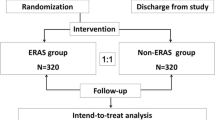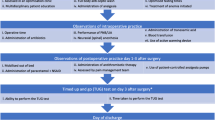Abstract
Purpose
Enhanced recovery after surgery (ERAS) protocols aim to develop peri-operative multidisciplinary programs to shorten length of hospital stay (LOS) and reduce complications, readmissions and costs for patients undergoing major surgery. The aim of this study is to evaluate the effects of an ERAS pathway for total hip (THR) and knee (TKR) replacement surgery in terms of length of stay, incidence of complications and patient satisfaction.
Methods
Patients scheduled for hip and knee replacement were included in the study. The main aspects of this program were preoperative education/physical therapy, rational choice of the anesthetic technique, optimization of multimodal analgesia, reduction of incidence of urinary retention and catheterization, active management of risk for blood loss and deep vein thrombosis, and early mobilization of the patients. All patients had 6 months predicted and planned follow-up appointments. Primary outcomes of the study were the mean LOS, readmission and complication rates. Secondary Outcomes were percentage of Knee Injury & Osteoarthritis Outcome Score (KOOS) and Hip disability and Osteoarthritis Outcome Score (HOOS) increase and patient’s satisfaction.
Results
We consecutively enrolled 207 patients who underwent total joint arthroplasty, 78 hip and 129 knee joint replacements. The mean length of stay (LOS) for patients of the two groups was 4.3 days for ASA 3-4 patients subjected to TKR and THR, in ASA 1-2 patients 3.6 days for TKR and 3.9 days for THR respectively. Postoperative satisfaction level was higher than 7 (very satisfied) in 94.4% of the cases. All patients were discharged home: 61.8% continued physical therapy in complete autonomy, 23.7% supported by a home-physiotherapist and only 14.5% needed the attendance to a physiotherapy center on a daily basis. The overall incidence of major complications was 3.4%.
Conclusions
The implementation of an ERAS program for hip and knee replacement surgery allows early patient’s discharge and a quick return to independency in the daily activities.
Level of evidence
IV.

Similar content being viewed by others
References
Ljungqvist O, Scott M, Fearon KC (2017) Enhanced recovery after surgery: a review. JAMA Surg 152:292–298
Scott MJ, Baldini G, Fearon KCH, Feldheiser A, Feldman LS, Gan TJ, Ljungqvist O, Lobo DN, Rockall TA, Schricker T, Carli F (2015) Enhanced recovery after surgery (ERAS) for gastrointestinal surgery, part 1: pathophysiological considerations. Acta Anaesthesiol Scand 59(10):1212–1231
Torre M, Romanini E, Zanoli G, Carrani E, Luzi I, Leone L, Bellino S (2016) Progetto Registro Italiano Artroprotesi—Controllo e Qualità dei Dati 2016: Istituto Superiore di Sanità
Jones EL, Wainwright TW, Foster JD, Smith JRA, Middleton RG, Francis NK (2014) A systematic review of patient reported outcomes and patient experience in enhanced recovery after orthopaedic surgery. Ann R Coll Surg Engl 96:89–94
Stambough JB, Nunley RM, Curry MC, Steger-May K, Clohisy JC (2015) Rapid recovery protocols for primary total hip arthroplasty can safely reduce length of stay without increasing readmissions. J Arthroplasty 30:521–526
McDonald S, Page MJ, Beringer K, Wasiak J, Sprowson A (2014) Preoperative education for hip or knee replacement. Cochrane Database Syst Rev. https://doi.org/10.1002/14651858.CD003526.pub3
Snow R, Granata J, Ruhil AV, Vogel K, McShane M, Wasielewski R (2014) Associations between preoperative physical therapy and post-acute care utilization patterns and cost in total joint replacement. JBJS 96:e165
Memtsoudis SG, Sun X, Chiu Y-L, Stundner O, Liu SS, Banerjee S, Mazumdar M, Sharrock NE (2013) Perioperative comparative effectiveness of anesthetic technique in orthopedic patients. Anesthesiol J Am Soc Anesthesiol 118:1046–1058
Johnson RL, Kopp SL, Burkle CM, Duncan CM, Jacob AK, Erwin PJ, Murad MH, Mantilla CB (2016) Neuraxial vs general anaesthesia for total hip and total knee arthroplasty: a systematic review of comparative-effectiveness research. Br J Anaesth 116:163–176
Frassanito L, Rodola F, Concina G, Messina A, Chierichini A, Vergari A (2008) The efficacy of the psoas compartment block versus the intrathecal combination of morphine, fentanyl and bupivacaine for postoperative analgesia after primary hip arthroplasty: a randomized single-blinded study. Eur Rev Med Pharmacol Sci 12:117–122
Vergari A, Frassanito L, Nestorini R, Caputo CT, Chierichini A, Di Stasio E, Rossi M (2017) Hypobaric versus isobaric spinal levobupivacaine for total hip arthroplasty. Minerva Anestesiol 83:361–368
Kopp SL, Børglum J, Buvanendran A, Horlocker TT, Ilfeld BM, Memtsoudis SG, Neal JM, Rawal N, Wegener JT (2017) Anesthesia and analgesia practice pathway options for total knee arthroplasty: an evidence-based review by the american and european societies of regional anesthesia and pain medicine. Reg Anesth Pain Med 42:683–697
Memtsoudis SG, Poeran J, Cozowicz C, Zubizarreta N, Ozbek U, Mazumdar M (2016) The impact of peripheral nerve blocks on perioperative outcome in hip and knee arthroplasty - a population-based study. Pain 157:2341–2349
Frassanito L, Vergari A, Zanghi F, Messina A, Bitondo M, Antonelli M (2010) Post-operative analgesia following total knee arthroplasty: comparison of low-dose intrathecal morphine and single-shot ultrasound-guided femoral nerve block: a randomized, single blinded, controlled study. Eur Rev Med Pharmacol Sci 14:589–596
Sankineani SR, Reddy ARC, Ajith Kumar KS, Eachempati KK, Reddy AVG (2018) Comparative analysis of influence of adductor canal block and multimodal periarticular infiltration versus adductor canal block alone on pain and knee range of movement after total knee arthroplasty: a prospective non-randomised study. Musculoskelet Surg 102(2):173–177
McGraw-Tatum MA, Groover MT, George NE, Urse JS, Heh V (2017) A prospective, randomized trial comparing Liposomal Bupivacaine vs Fascia Iliaca compartment block for postoperative pain control in total hip arthroplasty. J Arthroplasty 32:2181–2185
Bjerregaard LS, Bogø S, Raaschou S, Troldborg C, Hornum U, Poulsen AM, Bagi P, Kehlet H (2015) Incidence of and risk factors for postoperative urinary retention in fast-track hip and knee arthroplasty: a prospective, observational study. Acta Orthop 86:183–188
Tischler EH, Restrepo C, Oh J, Matthews CN, Chen AF, Parvizi J (2016) Urinary retention is rare after total joint arthroplasty when using opioid-free regional anesthesia. J Arthroplasty 31:480–483
Eachempati KK, Gurava Reddy AV, Apsingi S, Sankineani SR, Shaheed J, Dannana C (2017) A comparative analysis of the role of Tranexamic acid as an independent variable in reducing intraoperative blood loss in patients undergoing conventional total knee arthroplasty versus computer-assisted total knee arthroplasty. Musculoskelet Surg 101(3):255–259
Guerra ML, Singh PJ, Taylor NF (2015) Early mobilization of patients who have had a hip or knee joint replacement reduces length of stay in hospital: a systematic review. Clin Rehabil 29:844–854
Jans Ø, Kehlet H (2017) Postoperative orthostatic intolerance: a common perioperative problem with few available solutions. Can J Anesth 64:10–15
Administration F and D (2009) Guidance for industry: patient-reported outcome measures: use in medical product development to support labeling claims. Fed Regist 74:65132–65133
Desmeules F, Hall J, Woodhouse LJ (2013) Prehabilitation improves physical function of individuals with severe disability from hip or knee osteoarthritis. Physiother Can 65:116–124
Roos EM, Roos HP, Lohmander LS, Ekdahl C, Beynnon BD (1998) Knee Injury and Osteoarthritis Outcome Score (KOOS)—development of a self-administered outcome measure. J Orthop Sports Phys Ther 28:88–96
Klässbo M, Larsson E, Mannevik E (2003) Hip disability and osteoarthritis outcome score An extension of the Western Ontario and McMaster Universities Osteoarthritis Index. Scand J Rheumatol 32:46–51
Kelly E, Campbell J, Murray P (2013) Total hip replacement: patient satisfaction and early outcomes. Int J Health Care Qual Assur 26:262–268
Blom AW, Rogers M, Taylor AH, Pattison G, Whitehouse S, Bannister GC (2008) Dislocation following total hip replacement: the Avon Orthopaedic Centre experience. Ann R Coll Surg Engl 90:658–662
Lindahl H (2007) Epidemiology of periprosthetic femur fracture around a total hip arthroplasty. Injury 38:651–654
Ghanem E, Jaberi FM, Parvizi J (2007) Periprosthetic infection in a nutshell. Am J Orthop Belle Mead NJ 36:520–525
Author information
Authors and Affiliations
Corresponding author
Ethics declarations
Conflict of interest
The authors declare that they have no conflict of interest.
Ethical approval
All procedures performed in studies involving human participants were in accordance with the ethical standards of the institutional and/or national research committee and with the 1964 Helsinki declaration and its later amendments or comparable ethical standards.
Informed consent
Informed consent was obtained from all individual participants included in the study.
Additional information
Publisher's Note
Springer Nature remains neutral with regard to jurisdictional claims in published maps and institutional affiliations.
Rights and permissions
About this article
Cite this article
Frassanito, L., Vergari, A., Nestorini, R. et al. Enhanced recovery after surgery (ERAS) in hip and knee replacement surgery: description of a multidisciplinary program to improve management of the patients undergoing major orthopedic surgery. Musculoskelet Surg 104, 87–92 (2020). https://doi.org/10.1007/s12306-019-00603-4
Received:
Accepted:
Published:
Issue Date:
DOI: https://doi.org/10.1007/s12306-019-00603-4




